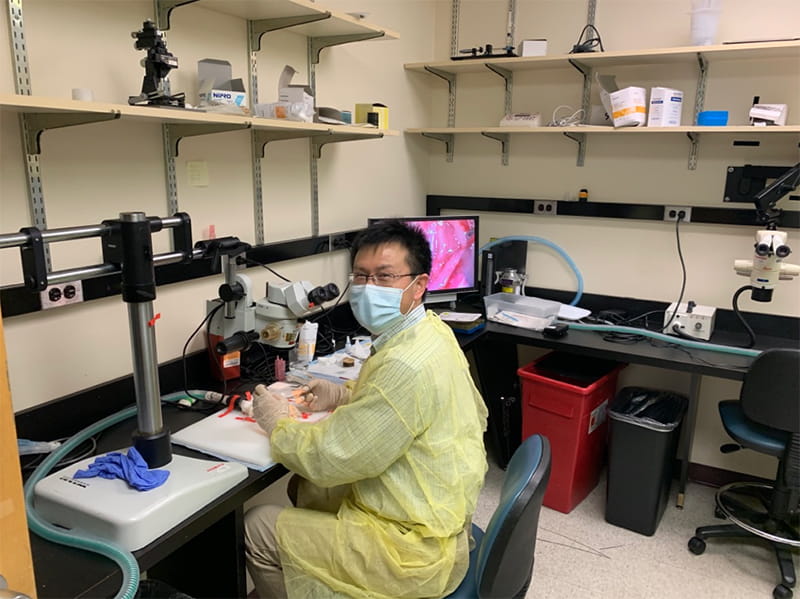Resiliency, Mentorship and $10 Million in Grants: Drexel Neurobiology & Anatomy in 2020

“I don’t count years. I count experiences.”
That’s what Itzhak Fischer, PhD, professor and chair of the Department of Neurobiology & Anatomy in Drexel University’s College of Medicine, said about being part of Drexel and its predecessor medical institutions since 1991, and department chair for 21 years. So, there have been plenty of experiences to count, but none that could ever compare to what happened in 2020.
When the COVID-19 pandemic hit in March, the University closed campus, teaching and learning shifted online, and research had ground to a halt — and no one had any idea what the next week would look like, let alone the rest of the year. The Department of Neurobiology & Anatomy found itself facing $500,000 in budget cuts as well as uncertainty in funding, especially after one of its well-funded investigators left, taking over $1.1 million with him from the department’s $9 million in annual research grants.
“I thought, ‘OK, we’re going to get a hit. How do we keep the $9 million?’” Fischer remembered. “And within a few months, instead of losing and going down from $9 million to $8 million, we are now approaching $10.5 million.”
Reached in September 2020, that record-breaking amount of funding came from the National Institutes of Health (NIH) and the Department of Defense (DoD) as well as the state and private foundations. It allowed the promotion of two faculty (Assistant Professors Simon Danner, PhD, and Jessica Ausborn, PhD) onto the tenure track. Danner became one of 11 researchers who received NIH R01 grants this year: two in his case, totaling $2.7 million over five years. Other faculty with new R01 grants included Assistant Professor Marie-Pascale Côté, PhD, ($1.8 million); Professor and Director of the Graduate Program in Neuroscience Peter Baas, PhD, ($3.2 million); Professor Veronica Tom, PhD, ($2.2 million, with two other NIH R01 grants) and Research Assistant Professor Liang Oscar Qiang, MD, PhD, ($1.8 million). The most recent update for 2020 showed 38 new grants totaling $26 million over five years.

This year was also successful for the other three departments in the College of Medicine’s four basic science departments: Biochemistry & Molecular Biology, Microbiology & Immunology and Pharmacology & Physiology. By the end of FY20, the basic sciences submitted almost 20 percent more in proposals than the previous year and received a 14 percent increase in awards.
For the Department of Neurobiology & Anatomy, this didn’t happen in spite of COVID-19, but because of how the pandemic recentered the ways in which its researchers approach projects. Fischer credits the lockdown with giving people time and space to process and generate new ideas, write papers, submit innovative grants and generally take the now-available time to pause and reflect on themselves and their long-term plans. The restrictions related to in-person courses at the University, in addition to the halted and then slowly phased return to research activity, did not weaken the foundation of mentorship, collaborative research and commitment to building community both inside and outside of the department.
“I think 2020 has been the best ever in 21 years of being a chair,” Fischer said. “The lesson is that even in difficult times, there are ways to continue to grow. You have to combine innovative elements and create a culture that is resilient and doesn’t depend on one person — or one chair, for that matter — so that you have a stable pipeline of ideas and students and faculty.”
For years, the department, and even individual labs, had been modeled to run like a small academic business. The Department of Neurobiology & Anatomy has strived to become self-sufficient and creative with external grant funding (like the $10.5 million in 2020) and increased revenue from outside of the budget (like online remediation courses offered to students from more than 40 medical schools, and summer camps for high school students). And with well-funded researchers bringing in their own money for a larger part of their salary with the added indirect cost, more money is freed up for departmental growth — particularly helpful in a rainy-day situation (or a year, or crisis) like 2020.
“Drexel’s neuroscience group has had a remarkable string of funding, and that’s due to many factors,” said Charles Cairns, MD, Walter H. and Leonore Annenberg Dean and senior vice president of medical affairs at Drexel University College of Medicine. “One of the primary factors is the leadership of the department through Dr. Fischer, the decision to focus on key areas like spinal cord injury and neuroinflammation, and the ability to bring in not only outstanding researchers, but people who are interested in crossing all missions from medicine, graduate school, education and training. The end result is this extraordinary group of faculty who are cohesive, work together and find synergy across their projects. This creates an academic ecosystem that’s really one of the world-leading groups for neuroscientists.”

In the last eight years, the department added 10 researchers, half of them as new faculty from an internal pool who moved to tenure-track only after they received a major NIH R01 grant using mostly departmental funds for their recruitment (as Danner and Ausborn just did). And those faculty, some of whom first came to the department as postdocs, receive mentorship from within the department, gain skills of an independent investigator and then, with external funding, move to a tenure-track position to become mentors for others — a feat Fischer calls “fourth-generation mentoring.” A key example: Tom (previously mentioned for receiving funding this year) came to the department as a postdoc with Professor John Houle, PhD; after receiving an R01 grant, she became an assistant professor and started mentoring and training her own postdocs — including Assistant Professor Shaoping Hou, PhD, who then received his R01 grant and is now in a tenure-track position in the department (with his own postdocs, of course).
“Community can really drive success, which is pointedly involved in mentoring people so that they can prosper professionally,” said Senior Vice Dean for Research and Professor of Pharmacology Kenny Simansky, PhD, who is a member and former director of the neuroscience graduate program. “That success translates into meeting our personal and institutional missions. Science is a very competitive enterprise, but internally it is not about competition. It’s about the culture that fosters accomplishment for everyone. Ultimately, when we train people, we want them to be capable of independently developing new ideas here and throughout their careers. That’s our obligation as a college. And this department does that exceedingly well.”
The experience of 2020 has also created change and opportunity within the department beyond funding and grants. Earlier this year, its graduate students organized a Neuroscience Students for Diversity group to work with faculty to increase diversity and expand Neurobiology & Anatomy’s welcoming and collaborative environment. Lab activity has been slowly, and safely, increasing with expanded hours, scheduled shifts and detailed precautions taken both inside the lab and throughout one’s arrival to the lab. The department (which does not teach undergraduates) has begun hiring Drexel co-op undergraduate students with computation and material engineering backgrounds mostly to work with faculty on research projects for the joint PhD/Master of Science in Neuroengineering program with Drexel’s School of Biomedical Engineering, Science and Health Systems.
The integration of co-ops is one way that the department has increased its cross-disciplinary work throughout the University. For almost 10 years, Neurobiology & Anatomy and the School of Biomedical Engineering, Science and Health Systems have maintained that joint Neuroengineering program— and Fischer and others in the department believe Drexel should create a framework that will allow similar joint programs across the University while reducing administrative obstacles. The other strategy is to have joint grants like the multi-PI R01s the department has with Drexel’s biomedical engineering and biology programs.
Neurobiology & Anatomy Professor Ramesh Raghupathi, PhD, has firsthand experience with interdisciplinary collaborations at Drexel. Earlier this year, he received one of Drexel’s Rapid Response Research Fund grants for faculty undertaking racial inequity research projects; he’s working with the A.J. Drexel Autism Institute’s Director and Professor Diana Robins, PhD, Assistant Professor Andrea Wiechowski and Associate Professor Giacomo Vivanti, PhD, on a project called “Does Racial Disparity Contribute to Delayed Diagnosis of Autism Spectrum Disorders in Children with Early Childhood Brain Injury?” And as the member of the Medicine Steering Committee in the Faculty Senate, Raghupathi is used to working with his colleagues from across the University to plan for and create a better, more unified Drexel.

With the College of Medicine’s future relocation to Drexel’s University City Campus in the next few years, the opportunities for interdisciplinary collaboration are going to be more plentiful than ever, Raghupathi said. As shared in a November DrexelNow update, Drexel’s 2020–2030 Strategic Plan calls for expanded research in health and health care technology, better aligned internal and external partnerships, and more adaptable and cutting-edge curricula and learning experiences.
“The budgets of the four basic science departments are driven by extramural research dollars which calls for enhanced support from the University administration,” said Raghupathi.
The COVID-19 pandemic has already demonstrated the University’s capability and strength in pivoting and creating new approaches to research, teaching and learning. New combined programs and collaborations across academic units could strengthen the University’s missions and increase enrollment and revenue.
“If I have a wish for Drexel at this difficult time, it’s to have a nimble and flexible system, consistent with the vision of President John Fry, that will facilitate research and look at expenses by grants as part of the solution for increased revenues. Receiving and spending grant money allows us to get indirect cost, allows us to keep the R1 status, allows us to attract outstanding students and faculty and therefore needs to have a fast approval track for hiring research personnel and for rewarding outstanding investigators,” Fischer said.
That’s just one of the ways in which, even after a long year and an even longer experience, Fischer is working to lead his department into the future while also finding solutions and opportunities in the present.
“I tell people in the department to remember how privileged and lucky we are to do what we do and enjoy every day of creative research and the company of people that we enjoy being with,” he said. “I tell them to have that perspective even in difficult times, and that they are the one percentile, not in terms of money but in terms of opportunities. The fact that you have advanced education and are in an academic environment comes with responsibility, and you have to contribute back to the community and develop inspirational leadership.”
And with this 2020 experience now coming to an end, the year is closing on a positive note. The College of Medicine has just announced that Fischer will receive the inaugural 2020 Daniel V. Schidlow, MD, Transformational Leader Award, which is presented to a faculty member exhibiting transformational leadership and the ability to inspire change and motivation for the College and all of its members.
In This Article
Drexel News is produced by
University Marketing and Communications.

